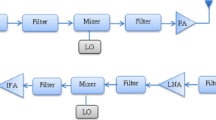Abstract
Reliable energy efficient information transmission is the primary design objective of a Wireless Sensor Network (WSN), considering its unique energy and resource constraints. Energy efficiency and bit error rate (BER) performance are the basic criteria to be taken into account while designing an optimal error correction scheme for WSNs. In this paper, a novel energy efficient error control scheme is proposed which minimizes the energy overheads of a typical error control scheme such as additional bits’ transmit energy and encoding/decoding energy, while achieving a better BER performance compared to the standard schemes. The redundant bits’ transmit energy is saved by incorporating compression and coding energy is minimized by employing simpler operations compared to other schemes. Further,the proposed scheme is validated in the context of mica2 motes. The BER performance and energy consumption of the presented scheme are studied and compared with standard error control schemes,such as, Hamming (7, 4) and RS (31, 29). Simulation results demonstrate the efficacy of the proposed methodology yielding a coding gain (CG) of 4.093 dB with a parameter selection of {30, 7, 2, 5}, in AWGN channel at BER of \(10^{-5}\), as compared to CG of 0.561 dB and 1.485 dB obtained using Hamming (7, 4) and RS (31, 29), respectively. Further, the standard codes above have a redundancy of 75% and 6.9% respectively while the proposed code with the above parameters achieves a compression of 23.81%. Quantification of energy consumption corresponding to each of the above schemes is also provided to prove the energy efficiency of the proposed technique.











Similar content being viewed by others
Explore related subjects
Discover the latest articles and news from researchers in related subjects, suggested using machine learning.Notes
Wireless Measurement System Mica2 Data Sheet, Document Part Number: 6020-0042-04.
AVRORA: The AVR simulation and Analysis Framework, Available at http://compilers.cs.ucla.edu/avrora/.
References
Dargie, W., & Poellabauer, C. (2010). Fundamentals of wireless sensor networks: Theory and practice. Hoboken: Wiley.
Akyildiz, I. F., Su, W., Sankarasubramaniam, Y., & Cayirci, E. (2002). Wireless sensor networks: A survey. Computer Networks, 38(4), 393–422.
Yick, J., Mukherjee, B., & Ghosal, D. (2008). Wireless sensor network survey. Computer Networks, 52(12), 2292–2330.
Nithya, V., Ramachandran, B., & Bhaskar, V. (2014). Energy efficient coded communication for ieee 802.15. 4 compliant wireless sensor networks. Wireless Personal Communications, 77(1), 675–690.
Chouhan, S., Bose, R., & Balakrishnan, M. (2009). A framework for energy-consumption-based design space exploration for wireless sensor nodes. IEEE Transactions on Computer-Aided Design of Integrated Circuits and Systems, 28(7), 1017–1024.
Abedi, A. (2011). Power-efficient-coded architecture for distributed wireless sensing. IET Wireless Sensor Systems, 1(3), 129–136.
Sankarasubramaniam, Y., Akyildiz, I. F., & McLaughlin, S. (2003). Energy efficiency based packet size optimization in wireless sensor networks. In Sensor network protocols and applications, 2003 IEEE international workshop on, IEEE (pp. 1–8).
Li, L., Maunder, R. G., Al-Hashimi, B. M., & Hanzo, L. (2013). A low-complexity turbo decoder architecture for energy-efficient wireless sensor networks. IEEE Transactions on Very Large Scale Integration (VLSI) Systems, 21(1), 14–22.
Yitbarek, YH., Yu, K., Åkerberg, J., Gidlund, M., & Björkman, M. (2014). Implementation and evaluation of error control schemes in industrial wireless sensor networks. In Industrial Technology (ICIT), 2014 IEEE International Conference on, IEEE, (pp. 730–735).
Xiong, Z., Liveris, A. D., & Cheng, S. (2004). Distributed source coding for sensor networks. IEEE Signal Processing Magazine, 21(5), 80–94.
Deligiannis, N., Zimos, E., Ofrim, D. M., Andreopoulos, Y., & Munteanu, A. (2015). Distributed joint source-channel coding with copula-function-based correlation modeling for wireless sensors measuring temperature. IEEE Sensors Journal, 15(8), 4496–4507.
Zhao, Y., & Garcia-Frias, J. (2006). Turbo compression/joint source-channel coding of correlated binary sources with hidden markov correlation. Signal Processing, 86(11), 3115–3122.
Garcia-Frias, J., Zhao, Y., & Zhong, W. (2007). Turbo-like codes for transmission of correlated sources over noisy channels. IEEE Signal Processing Magazine, 24(5), 58–66.
Akyildiz, I. F., & Vuran, M. C. (2011). Theory and design of digital communication systems. New York: Cambridge University Press.
Proakis, J. (2001). Digital communications. Boston: McGraw-Hill.
Ha, T. (2011). Theory and design of digital communication systems. New York: Cambridge University Press.
Wells, R. (1999). Applied coding and information theory for engineers. Upper Saddle River, N.J.: Prentice Hall.
Chouhan, S., Balakrishnan, M., & Bose, R. (2012). System-level design space exploration methodology for energy-efficient sensor node configurations: An experimental validation. IEEE Transactions on Computer-Aided Design of Integrated Circuits and Systems, 31(4), 586–596.
Lee, T. H. (2003). The design of CMOS radio-frequency integrated circuits. Cambridge: Cambridge University Press.
Titzer, BL., Lee, DK., & Palsberg, J. (2005). Avrora: Scalable sensor network simulation with precise timing. In Proceedings of the 4th international symposium on Information processing in sensor networks, IEEE Press, (p. 67).
Chipcon AS. SmartRF® CC1000 Datasheet (rev. 2.2) 2004-04-22. Retrieved from http://www.astlab.hu/pdfs/cc1000.pdf.
Dezfouli, B., Radi, M., Razak, S. A., Hwee-Pink, T., & Bakar, K. A. (2015). Modeling low-power wireless communications. Journal of Network and Computer Applications, 51, 102–126.
Sklar, B. (1988). Digital communications. Englewood Cliffs, N.J.: Prentice-Hall.
Author information
Authors and Affiliations
Corresponding author
Rights and permissions
About this article
Cite this article
Resmi, N.C., Chouhan, S. A Novel Interdependent Source-Channel Coding Technique for Enhanced Energy Efficiency in Communication over Wireless Sensor Networks. Wireless Pers Commun 96, 3727–3743 (2017). https://doi.org/10.1007/s11277-017-4068-8
Published:
Issue Date:
DOI: https://doi.org/10.1007/s11277-017-4068-8




